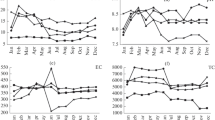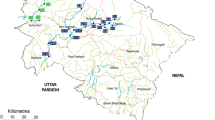Abstract
The use of a few indicators of hydrologic alteration can minimize statistical redundancy which can lead to take effective environmental flow management decisions. The aim of the research is to select representative dominant indicators of hydrological alteration through reducing the dimensionality of multivariate data for the Gorai river, Bangladesh. The required mean daily discharge data (1976–2006) of the Gorai have been collected from the Bangladesh Water Development Board. The Range of Variability Approach and anomaly of the river flow show hydrologic alteration in recent years comparing with past. Principal component analysis (PCA) in Kendall and Pearson methods has been performed by the XLSTAT software (version 2.9). Depending on eigenvalues (>1.0), seven and six Principal components (PCs) are selected for Kendall and Pearson methods, respectively, for further analysis. Since the eco-flow metrics of eco-deficit of the river has poor correlation with the indicators of hydrologic alteration, the resultant loadings are subjected to the Kaiser–Meyer–Olkin (KMO) Measure of Sampling Adequacy (MSA) method which is classified into marvelous, meritorious, middling, mediocre, and miserable based on the PC loading values. Seven indicators have been found whose PC loadings are in marvelous class and are common for both Kendall and Pearson methods. These indicators, named March mean flow, 1-day minimum mean, 3-day minimum mean, 7-day minimum mean, 30-day minimum mean, 90-day minimum mean, and 30-day maximum mean flows, are the desired indicators of hydrologic alteration of the Gorai river.




Similar content being viewed by others

References
Adams WC (1919) History of the Rivers in the Genetic delta. East Pakistan. Bengal Secretariat Press, Dhaka
Arthington AH, Bunn SE, Poff NL, Naiman RJ (2006) The challenge of providing environmental flow rules to sustain river ecosystems. Ecol Appl 16(4):1311–1318
Arthington AH, James CS, Mackay SJ, Rolls R, Sternberg D, Barnes A (2012) Hydro-ecological relationships and thresholds to inform environmental flow management, Science Report. International Water Centre, Brisbane
Bharati L, Jayakody P (2011) Hydrological impacts of inflow and land-use changes in the Gorai River catchment, Bangladesh. Water Int 36(3):357–369
Castellarin A, Vogel RM, Brath A (2004) A stochastic index flow model of flow duration curves. Water Resour Res 40:W03104
Dunteman GH (1989) Principal Components Analysis. Sage Publications, Newbury Park
EGIS (2000) Environmental baseline of Gorai river restoration project, Environmental and Geographical Information System (EGIS)-II. Bangladesh Water Development Board, Ministry of Water Resources, Dhaka
Gao Y, Vogel RM, Kroll CN, Poff NL, Olden JD (2009) Development of representative indicators of hydrologic alteration. J Hydro 374:136–147
Gao B, Yang D, Zhao T, Yang H (2012) Changes in the eco-flow metrics of Upper Yangtze River from 1961 to 2008. J Hydro 448–449:30–38
Genz F, Luz LD (2012) Distinguishing the effects of climate on discharge in a tropical river highly impacted by large dams. Hydro Sci J 57:1020–1034
Gotelli NJ, Ellison AM (2004) A Primer of Ecological Statistics. Sinauer Associates Inc., Sunderland
IECO (1980) Southwest Regional Plan: Supplement e: saline intrusion and tidal hydraulics; supplement f: environment and ecology (part I & II), supplement g: fishery (part I & II), supplement h: forestry (part I&II), Supplement i: navigation; supplement j: augmentation of the dry-season flows of the Ganges. Bangladesh Water Development Board, Dhaka
Islam SN, Gnauck A (2011) Water shortage in the Gorai river basin and damage of mangrove wetland ecosystems in Sundarbans, Bangladesh. 3rd International Conference on Water & Flood Management (ICWFM-2011), Dhaka, Bangladesh
James FC, McCulloch CE (1990) Multivariate analysis in ecology and systematics: panacea or Pandora’s Box? Annu Rev Ecol Syst 21:129–166
Kaiser HF (1974) An index of factor simplicity. Psychometrika 39:31–36
Legendre P, Legendre L (1998) Numerical ecology. Elsevier, Amsterdam
Liu C, Lin K, Kuo Y (2003) Application of factor analysis in the assessment of groundwater quality in a blackfoot disease area in Taiwan. Sci Total Env 313:77–89
Mathews R, Richter BD (2007) Application of the indicators of hydrologic alteration software in environmental flow setting. J Am Water Res Assoc 43:1400–1413
McGarigal K, Cushman S, Stafford SG (2000) Multivariate statistics for wildlife and ecology research. Springer, New York
Moly SH, Rahman MATM, Saadat AHM (2015) Environmental flow characteristics of the Gorai River, Bangladesh. Int J Sci Res Env Sci 3(6):208–218
Mullick RA, Babel MS, Perret SR (2010) Flow characteristics and environmental flow requirements for the Teesta River, Bangladesh. Proceedings of International Conference on Environmental Aspects of Bangladesh (ICEAB10), Japan
Olden JD, Poff NL (2003) Redundancy and the choice of hydrologic indices for characterizing stream flow regimes. River Res Appl 19:101–121
Richter BD, Baumgartner JV, Powell J, Braun DP (1996) A method for assessing hydrologic alteration within ecosystems. Conserv Biol 10:1163–1174
Richter BD, Baumgartner JV, Wigington R, Braun DP (1997) How much water does a river need? Freshw Biol 37:231–249
Ripl W (2003) Water: the bloodstream of the biosphere. Philos Trans R Soc Lond Ser B 358:1921–1934
Robertson MP, Caithness N, Villet MH (2001) A PCA-based modeling technique for predicting environmental suitability for organisms from presence records. Divers Distrib 7:15–27
Salehi A, Amiri GZ (2005) Study of physical and chemical soil properties variations using principal component analysis method in the forest, North of Iran. Casp J Env Sci 3(2):131–137
Sewell M (2008) Principal component analysis. University College London, London
Smakhtin, VU (2001) Estimating continuous monthly baseflow time series and their possible applications in the context of the ecological reserve. Water SA 27(2):213–217
Tabachnik BG, Fiddell LS (1989) Using multivariate statistics. Harper Collins, New York
TNC (2009) Indicators of hydrologic alteration version 7.1, user’s manual. The Nature Conservancy, Virginia
WB (2008) Integrating environmental flows into hydropower dam planning, design and operation. World Bank, Washington, DC
Yang YC, Cai X, Herricks EE (2008) Identification of hydrologic indicators related to fish diversity and abundance, a data mining approach for fish community analysis. Water Res Res. doi:10.1029/2006WR005764
Author information
Authors and Affiliations
Corresponding author
Rights and permissions
About this article
Cite this article
Rahman, M.A.T.M.T., Hoque, S. & Saadat, A.H.M. Selection of minimum indicators of hydrologic alteration of the Gorai river, Bangladesh using principal component analysis. Sustain. Water Resour. Manag. 3, 13–23 (2017). https://doi.org/10.1007/s40899-017-0079-6
Received:
Accepted:
Published:
Issue Date:
DOI: https://doi.org/10.1007/s40899-017-0079-6



